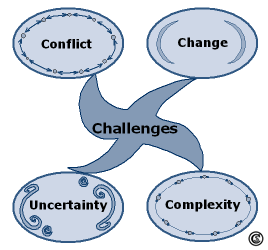Challenges for planners and managers
Natural resource planners and managers as well as rural development planners are faced with varied and frequently interconnected challenges (see figure):
Change: In our natural and human systems more or less rapid changes are always occurring. Many of these changes are triggered by human activities. First, planners and managers have to consider these possible changes in their decision-making. The plans have to be flexible. Second, planners and managers have to perceive actual changes and adapt their plans and management accordingly (Mitchell 2002).
Complexity: The interdependence of natural systems and the ramifications of interactions of human activity with the natural environment are complex. Planners and managers have to understand the different components, processes, and their interactions very well to develop sustainable management and development strategies for the specific system (see interactions of geospheres) (Mitchell 2002; O'Riordan 1996).
Uncertainty: Due to the complexity and changes, planners and managers do not have complete information about all factors influencing the decision. Nevertheless, they have to make decisions despite their lack of information about the ecosystem for which their decisions have consequences (Ewert et al. 2004; Mitchell 2002).
Conflict: Different, and often conflicting, values and perspectives are usually involved in resource allocation and use decision. Planners and managers are often faced with conflict situations and have to recognise and mediate between the conflicting sides. This is associated with the intergenerational and intragenerational equity implied in the term sustainability (Mitchell 2002).
How can planners cope with these challenges? This is the topic of the next three learning pages.
